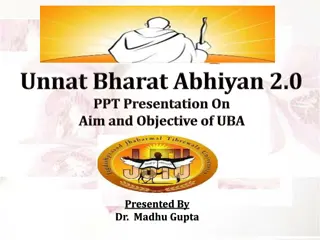
Land Revenue Systems in Colonial India
Explore the land revenue systems of Colonial India including the Permanent Settlement, Mahalwari System, and Ryotwari System. Learn about their introduction, features, and impact on peasants and society. Discover the complexities of revenue collection and the implications for the agricultural economy during this period.
Download Presentation

Please find below an Image/Link to download the presentation.
The content on the website is provided AS IS for your information and personal use only. It may not be sold, licensed, or shared on other websites without obtaining consent from the author. If you encounter any issues during the download, it is possible that the publisher has removed the file from their server.
You are allowed to download the files provided on this website for personal or commercial use, subject to the condition that they are used lawfully. All files are the property of their respective owners.
The content on the website is provided AS IS for your information and personal use only. It may not be sold, licensed, or shared on other websites without obtaining consent from the author.
E N D
Presentation Transcript
SNS ACADEMY A fingerprint International School Affiliated to CBSE New Delhi Affiliation No :1930610 GRADE : 8 (2022-23) 1 COURSE NAME : SOCIAL SCIENCE History Chapter-3 Life in the Rural Area
https://youtu.be/18Za0mRXe4E https://youtu.be/cj Aryd3hYEQ
The company introduced three new revenue collection systems. The Permanent settlement The Mahalwari system and Ryotwari system THE PERMANENT SETTLEMENT Introduced by Lord Cornwallis-1793 To ensure regular income for the company. To fix the land revenue of Bengal and Bihar on a permanent basis.
The main Features The revenue collected from the area was fixed. It won't be revised later. Local Zamindars collected this from the peasants. Every year the Zamindar had to pay the fixed amount permanently in the fixed date. Surplus revenue from the land also can collect..Zamindars can keep the surplus amount. In case the Zamindar could not pay the stipulated amount , he would lose his zamindari rights. The land will be given to another Zamindar.
Cont.. This advance revenue fixing system was extremely advantageous to the company. It ensured fixed and regular income. It also created new social class- Landlords They were loyal to the British. The condition of peasants under this System The peasants suffered terribly . They paid very high revenue. Evicted - If they failed to pay the revenue . Zamindars were not interested in investing the productivity of the land. So production declined-peasants are forced to borrow money from the money lenders. Peasants once they are in dept, they felt it difficult to come out.
MAHALWARI SYSTEM Introduced by Holt Mackenzie (British colonial administrator in India) in 1822. This system was introduced in present Uttar Pradesh parts of Madhya Pradesh and Punjab. In these area land was commonly owned by the group of villages called Mahals . The village headman was given the responsibilities revenue collection . This revenue was not fixed permanently. It could be revised periodically.
RYOTWARI SYSTEM This system was developed by Thomas Munro in Madras and Bombay. Gradually implemented all over south India. Under this system company collected revenue from the ryots or peasant directly The farmer was recognized as the owner of the land so they paid the land revenue. Revenue also fixed according to the fertility of the soil.
IMPACT OF REVENUE SYSTEM The land revenue settlements introduced by the company impoverished the peasants. Land now become a saleble commodity, which could be bought ,sold or mortgaged(pledged) This had a deep impact on rural life and economy.
IMPOVERISHMENT OF THE PEASANTRY During company rule Peasants survived on very small incomes. Failure of crops and costly social customs like marriage and festivals Forced the peasants either sell part of their land. Or borrow money from the money lenders. Peasants always refused to sell their land because they considered land their land as their mother. The money lenders mortgaged the land of the peasants and charged high rate of interest.
Most peasants were unable to repay the money. So the mortgaged land was taken away by the money lender. Landless peasant found it impossible to support his family. According to a government survey in the mid 19th century eight out of every 10 peasants had unpaid debts.
The new revenue system created a new class zamindars. They were not for the welfare of the farmers. Their only aim was extracting maximum from the farmers. They did nothing to improve agriculture. Irrigation facilities were almost not existed Peasants entirely dependent on monsoons. Failure of rains in any year brought about famines. This condition farmers could not support himself and their family , because they won t have any other source of income.
CULTIVATION OF CASH CROPS The 19th century cultivation of cash crops increased. Cash crops such as indigo,jute, oilseeds, sugarcane, tea, coffee and cotton. Company encouraged to cultivate these crops widely because it is used in British manufacturing industries. British officers forced the peasants to cultivate this crops in their fields. It resulted in a decline in the production of food grains. It created acute shortage of food supply.
INDIGO OR NEEL Indigo is a blue coloured dye obtained from indigo plant. Used to dye cloth. Great demand in Europe. Climate of England was not suitable for growing indigo, so it imported from West Indies and North America. By 18th century indigo cultivation collapsed in these area, it started looking supplies from other areas. To meet its growing demand for indigo Britain turned in to India.
Since medieval period small portion of land was used for indigo cultivation in India. The company forced the farmers in Bengal to cultivate only Indigo. Since 19th century Indian indigo exported more to England. It fetched huge profits to the company. Some officials of the company started invested privately in indigo plantation. It is an labour intensive job so planters asked to sign a contract with the cultivator that he could sow only indigo.
Price paid to the cultivator was very less. In 1860 Dinabandu Mitra wrote a play called Neel Darpan(the indigo planting mirror). In this he highlighted the atrocities of indigo planters on the indigo cultivators. Indigo cultivators are not free to sow other crops. This crop exhausted the fertility of the soil.
INDIGO OR BLUE REBELLION Thousands of peasants in Bengal refused to grow indigo in March 1859. The cultivators attacked the indigo factories. The gomasthas are agents of the planters were beaten in many places. Peasants also boycotted in European owned plantations. Even women took a part against the planters. Local Zamindars also joined with peasants in some places. This rebellion forced the government to act immediately . Indigo commission was set up to look into the system of indigo production and suggest changes. Bengal stopped being the hub of indigo cultivation. The planters shifted to Bihar. Exploitation of the indigo cultivators still continued Mahatma Gandhi fought for the case of indigo farmers.






















